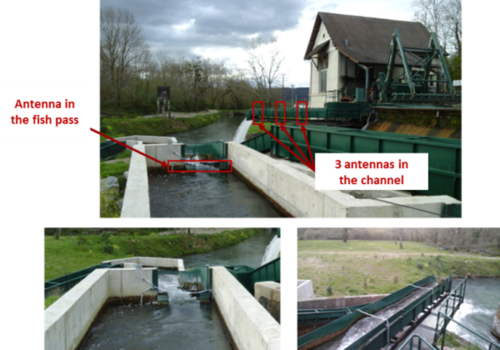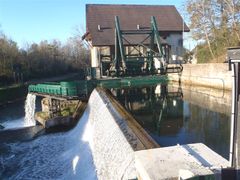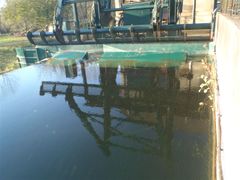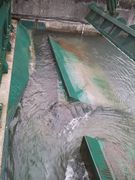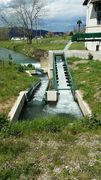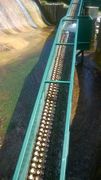Difference between revisions of "Gotein test case"
Bendikhansen (talk | contribs) |
|||
| (34 intermediate revisions by 2 users not shown) | |||
| Line 8: | Line 8: | ||
There are 3 hydropower plants (HPPs) and one fish farm on the Saison. | There are 3 hydropower plants (HPPs) and one fish farm on the Saison. | ||
| − | The hydrology of the Saison is characterized by sustained flows in winter, high water levels in spring due to snow melting and a low water period from August to October. At Gotein the mean interannual discharge is estimated at 22.3 | + | The hydrology of the Saison is characterized by sustained flows in winter, high water levels in spring due to snow melting and a low water period from August to October. At Gotein the mean interannual discharge is estimated at 22.3 m<sup>3</sup>/s. |
=About the hydropower plant= | =About the hydropower plant= | ||
| − | The HPP of Gotein is a run of river HPP with an installed capacity of 0.32 MW. | + | The HPP of Gotein is a run of river HPP with an installed capacity of 0.32 MW. The bypass reach is 2260 meters long and the headrace canal is 770 meters long. The turbine on site is a Kaplan turbine with a maximum turbined flow of 6.6 m<sup>3</sup>/s and a rated head of 5.81 m. |
| − | |||
| − | ===The Operator: | + | ===The Operator: === |
| + | The HPP Gotein is operated by the ''Société Hydroélectrique de Gotein'', which is a small company responsible for operating two small HPPs. | ||
=Pressures on the water body's ecosystem= | =Pressures on the water body's ecosystem= | ||
| Line 24: | Line 24: | ||
An inclined bar rack (inclination 26°, bar spacing 20 mm) ist located infront of the HPP to protect the fish on their downstream migration. 5.4% of the turbine flow is allocated for downstream migration. | An inclined bar rack (inclination 26°, bar spacing 20 mm) ist located infront of the HPP to protect the fish on their downstream migration. 5.4% of the turbine flow is allocated for downstream migration. | ||
===Upstream migration=== | ===Upstream migration=== | ||
| − | At the dam, the fishes can use a pre-barrage fish pass to go upstream (2014). A flow of 1 | + | At the dam, the fishes can use a pre-barrage fish pass to go upstream (2014). A flow of 1 m<sup>3</sup>/s is maintained in the pass. The pass has two pools of 38 and 45 m<sup>2</sup>. It targets the fishes using the bypassed reach to go upstream. |
At the powerplant, the fishes can use a baffle fishpass composed of 5 portions of 7.5 m with a 16% slope. The portions are connected by pools (3.0x2.0x1.0m). The flow in the fishpass is 150 l/s. There is a specific device for eels: it is composed of 4 portions, each 4 to 6 m long, with a 25 to 30 % slope. These are connected by resting pools (1.5x1.0x0.5m). The flow allocated to the fish pass is only a few liters per second. These devices target the fish using the tailrace channel to go upstream. | At the powerplant, the fishes can use a baffle fishpass composed of 5 portions of 7.5 m with a 16% slope. The portions are connected by pools (3.0x2.0x1.0m). The flow in the fishpass is 150 l/s. There is a specific device for eels: it is composed of 4 portions, each 4 to 6 m long, with a 25 to 30 % slope. These are connected by resting pools (1.5x1.0x0.5m). The flow allocated to the fish pass is only a few liters per second. These devices target the fish using the tailrace channel to go upstream. | ||
| Line 30: | Line 30: | ||
In France, the law of 2006 (LEMA) imposes an e-flow of 1/10 of the mean inter-annual discharge before 1rst January 2014. They are two options for the environmental flow in the bypass section. | In France, the law of 2006 (LEMA) imposes an e-flow of 1/10 of the mean inter-annual discharge before 1rst January 2014. They are two options for the environmental flow in the bypass section. | ||
| − | The first one is a minimum value equal to a tenth of the mean interannual discharge of the water course. It’s the value chosen in Gotein 2.5 | + | The first one is a minimum value equal to a tenth of the mean interannual discharge of the water course. It’s the value chosen in Gotein 2.5 m<sup>3</sup>/s. |
The second one is a minimum biological flow value. It is calculated thanks to deep habitat studies. In the case of the value founded with the study is greater than the minimum value, it becomes the new minimum flow. If it’s smaller, the minimum flow stays equal to the tenth of the mean interannual discharge. | The second one is a minimum biological flow value. It is calculated thanks to deep habitat studies. In the case of the value founded with the study is greater than the minimum value, it becomes the new minimum flow. If it’s smaller, the minimum flow stays equal to the tenth of the mean interannual discharge. | ||
| Line 38: | Line 38: | ||
The research task and field studies conducted at Gotein are: | The research task and field studies conducted at Gotein are: | ||
| − | * Radiotelemetry fish tracking (Atlantic salmon smolts | + | * Radiotelemetry fish tracking (Atlantic salmon smolts) for the assessment of the bar rack efficiency |
| + | * Characterization by measurement of the flow repartition between the 2 bypass entrances | ||
| + | * Hydraulic modelling of the of the fishfriendly water intake in order to characterize the attractiveness of the bypasses; | ||
| + | |||
=Results= | =Results= | ||
| − | [[file:gotein_antennas.png|thumb|500px| | + | [[file:gotein_antennas.png|thumb|500px|Overview of Gotein test case HPP And antennas for fish tracking]] |
| + | |||
The Gotein test case consists in a small HPP with a fish friendly water intake. Most of current design recommendations are respected on this test case for both upstream and downstream migration. This test case is used for evaluating the efficiency of an inclined low bar spacing trashrack and for validating the discharge calculated using 3D modelling inside the bypasses. Pit-tag measurements have been carried out on six batches of 50 smolts over days during which the discharge varied. Fishes were released in the headrace channel and used a variety of paths to migrate downstream. ADCP measurements have been used to monitor the discharge of the HPP and a flowmeter was used to monitor the discharge in the two bypasses entrances of the bar rack. Some dissymmetry has been observed and confirmed with 3D numerical modelling. In average, 80.9% of the fishes went through the downstream migration device and 2% used the fish pass. A better efficiency is observed for fishes released in the evening, with increases in the range of 13% to 22%. | The Gotein test case consists in a small HPP with a fish friendly water intake. Most of current design recommendations are respected on this test case for both upstream and downstream migration. This test case is used for evaluating the efficiency of an inclined low bar spacing trashrack and for validating the discharge calculated using 3D modelling inside the bypasses. Pit-tag measurements have been carried out on six batches of 50 smolts over days during which the discharge varied. Fishes were released in the headrace channel and used a variety of paths to migrate downstream. ADCP measurements have been used to monitor the discharge of the HPP and a flowmeter was used to monitor the discharge in the two bypasses entrances of the bar rack. Some dissymmetry has been observed and confirmed with 3D numerical modelling. In average, 80.9% of the fishes went through the downstream migration device and 2% used the fish pass. A better efficiency is observed for fishes released in the evening, with increases in the range of 13% to 22%. | ||
| Line 67: | Line 71: | ||
=Gallery= | =Gallery= | ||
| − | <gallery> | + | <gallery mode=packed> |
| − | Gotein-1-Global-View.jpg | + | Gotein-1-Global-View.jpg|Overview of Gotein HPP. |
| − | Gotein-2-Rack-And-Bypasses.jpg | + | Gotein-2-Rack-And-Bypasses.jpg|Gotein inclined bar rack and fish bypass. |
| − | Gotein-3-Bypasses-And-Collection-Gallery.jpg | + | Gotein-3-Bypasses-And-Collection-Gallery.jpg|Gotein fish collection gallery and bypass. |
| − | Gotein-4-Baffle_fishway.jpg | + | Gotein-4-Baffle_fishway.jpg|Gotein Baffle Fishway. |
| − | Gotein-5-Eelpass.jpg | + | Gotein-5-Eelpass.jpg|Gotein Eel pass. |
</gallery> | </gallery> | ||
| + | |||
| + | =References= | ||
| + | * Tomanova S., Courret D., Alric A., De Oliveira E., Lagarrigue T., Tetard S. (2018)Étude d'efficacité des exutoires associés à des grilles inclinées ou orientées pour la dévalaison des smolts de saumon atlantique. https://doi.org/10.13140/RG.2.2.11387.21283 | ||
| + | |||
| + | * Tomanova S., Courret D., Alric A., De Oliveira E., Lagarrigue T., Tétard T., (2018). Protecting efficiently sea-migrating salmon smolts from entering hydropower plant turbines with inclined or oriented low bar spacing racks Ecological Engineering 122 (2018) 143–152. https://doi.org/10.1016/j.ecoleng.2018.07.034 | ||
Latest revision as of 16:37, 30 May 2020
| Fact box: Gotein | |
|---|---|
| Country | France |
| River | Saison |
| Operator | Société Hydroélectrique de Gotein |
| Capacity | 0.32 MW |
| Head | 5.81 m |
| Inter-annual discharge | 22.3 m3/s |
| Turbine(s) | 1 Kaplan turbine |
| Detailed report | Click for pdf |
Contents
Introduction
The Test Case Gotein is located on the Saison in the southwest of France. The Saison has a total length of 54 km long and flows along the Pyrenees. Itis a tributary to Gave D’Oloron, which flows into the Adour river.
There are 3 hydropower plants (HPPs) and one fish farm on the Saison.
The hydrology of the Saison is characterized by sustained flows in winter, high water levels in spring due to snow melting and a low water period from August to October. At Gotein the mean interannual discharge is estimated at 22.3 m3/s.
About the hydropower plant
The HPP of Gotein is a run of river HPP with an installed capacity of 0.32 MW. The bypass reach is 2260 meters long and the headrace canal is 770 meters long. The turbine on site is a Kaplan turbine with a maximum turbined flow of 6.6 m3/s and a rated head of 5.81 m.
The Operator:
The HPP Gotein is operated by the Société Hydroélectrique de Gotein, which is a small company responsible for operating two small HPPs.
Pressures on the water body's ecosystem
The hydrology of the Saison is highly altered by the hydropower plant of Sainte-Engrâce located more than 25 km upstream, which runs with hydropeaking. The continuity is altered by several weirs and HPPs along its course.
Test case topics
Fish population
The river is dominated by cyprinids and salmonids.
Downstream migration
An inclined bar rack (inclination 26°, bar spacing 20 mm) ist located infront of the HPP to protect the fish on their downstream migration. 5.4% of the turbine flow is allocated for downstream migration.
Upstream migration
At the dam, the fishes can use a pre-barrage fish pass to go upstream (2014). A flow of 1 m3/s is maintained in the pass. The pass has two pools of 38 and 45 m2. It targets the fishes using the bypassed reach to go upstream.
At the powerplant, the fishes can use a baffle fishpass composed of 5 portions of 7.5 m with a 16% slope. The portions are connected by pools (3.0x2.0x1.0m). The flow in the fishpass is 150 l/s. There is a specific device for eels: it is composed of 4 portions, each 4 to 6 m long, with a 25 to 30 % slope. These are connected by resting pools (1.5x1.0x0.5m). The flow allocated to the fish pass is only a few liters per second. These devices target the fish using the tailrace channel to go upstream.
E-flow
In France, the law of 2006 (LEMA) imposes an e-flow of 1/10 of the mean inter-annual discharge before 1rst January 2014. They are two options for the environmental flow in the bypass section.
The first one is a minimum value equal to a tenth of the mean interannual discharge of the water course. It’s the value chosen in Gotein 2.5 m3/s.
The second one is a minimum biological flow value. It is calculated thanks to deep habitat studies. In the case of the value founded with the study is greater than the minimum value, it becomes the new minimum flow. If it’s smaller, the minimum flow stays equal to the tenth of the mean interannual discharge.
Research objectives and tasks
The test case site of Gotein is a small HPP with a fishfriendly water intake. For FIThydro, the efficiency of this water intake will be assessed. To assess the influence of the bypass and undertake modifications of the flow conditions, hydraulic modelling will be done for the entrance of the HPP.
Research tasks
The research task and field studies conducted at Gotein are:
- Radiotelemetry fish tracking (Atlantic salmon smolts) for the assessment of the bar rack efficiency
- Characterization by measurement of the flow repartition between the 2 bypass entrances
- Hydraulic modelling of the of the fishfriendly water intake in order to characterize the attractiveness of the bypasses;
Results
The Gotein test case consists in a small HPP with a fish friendly water intake. Most of current design recommendations are respected on this test case for both upstream and downstream migration. This test case is used for evaluating the efficiency of an inclined low bar spacing trashrack and for validating the discharge calculated using 3D modelling inside the bypasses. Pit-tag measurements have been carried out on six batches of 50 smolts over days during which the discharge varied. Fishes were released in the headrace channel and used a variety of paths to migrate downstream. ADCP measurements have been used to monitor the discharge of the HPP and a flowmeter was used to monitor the discharge in the two bypasses entrances of the bar rack. Some dissymmetry has been observed and confirmed with 3D numerical modelling. In average, 80.9% of the fishes went through the downstream migration device and 2% used the fish pass. A better efficiency is observed for fishes released in the evening, with increases in the range of 13% to 22%.
The efficiency of the downstream migration device at the Gotein HPP is 80.9 % and the global survival rate of Gotein is 98.72%.
| Dam | Power plant | Total survival rate at Gotein | |||
|---|---|---|---|---|---|
| Proportion (%) of fishes passing over the spillway of the dam | Proportion (%) of fishes led to headrace channel | Proportion (%) of fishes passing through the turbine | Mortality through the turbine (%) | Proportion (%) of fishes assumed dead due to passage through the turbine | |
| 32.4 | 67.6 | 11.61 | 11 | 1.28 | 98.72 |
The table above is a summary of the distribution of fishes passing through the different ways: passage rate through the turbines (this study) and their mortality rates, and global passage efficiency taking into account passage over the spillway, the downstream migration device and survival after passage through turbines (Tomanova, et al., 2018)
Gallery
References
- Tomanova S., Courret D., Alric A., De Oliveira E., Lagarrigue T., Tetard S. (2018)Étude d'efficacité des exutoires associés à des grilles inclinées ou orientées pour la dévalaison des smolts de saumon atlantique. https://doi.org/10.13140/RG.2.2.11387.21283
- Tomanova S., Courret D., Alric A., De Oliveira E., Lagarrigue T., Tétard T., (2018). Protecting efficiently sea-migrating salmon smolts from entering hydropower plant turbines with inclined or oriented low bar spacing racks Ecological Engineering 122 (2018) 143–152. https://doi.org/10.1016/j.ecoleng.2018.07.034
